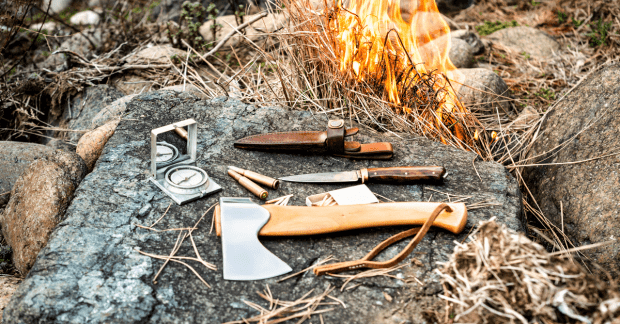Did you know that the average person can survive without water for only three days? Or that shouting for help isn’t always the best strategy in a survival situation? You might be surprised to learn that there is a science behind survival, and understanding it can make all the difference in a life-or-death situation.
In this article, we delve into the surprising science of survival and reveal seven must-know facts that could save your life. From the psychological impact of stress on decision-making to the importance of staying hydrated, these facts are backed by research and expert advice. Whether you’re an outdoor enthusiast, preparing for a natural disaster, or simply want to be better equipped to handle emergencies, this article is a must-read.
Discover the power of the human body’s survival mechanisms, and learn practical strategies to increase your chances of making it out of a dangerous situation alive. Survival isn’t just about luck; it’s about knowledge and preparation. So, arm yourself with these essential facts and be ready for anything that comes your way.

The 5 Second Rule
by Mel Robbins
⏱ 12 minute reading time
🎧 Audio version available
The rule of threes: Prioritizing survival needs
When faced with a survival situation, it’s crucial to prioritize your needs based on the rule of threes. This rule suggests that you can only survive for three minutes without air, three hours without shelter in extreme weather conditions, three days without water, and three weeks without food. Understanding this prioritization is vital to ensure your survival.
To begin with, let’s focus on the most immediate need: air. Without air, our brains start to suffer, and within just a few minutes, we can experience irreversible damage or even death. Ensuring that you have a constant supply of fresh air should always be your first priority.
Next, shelter becomes essential, especially in extreme weather conditions. Exposure to extreme cold or heat can quickly lead to hypothermia or heatstroke. Understanding how to create a makeshift shelter using available resources can significantly increase your chances of survival.
Water is another critical aspect of survival. Dehydration can set in within days, leading to weakness, confusion, and ultimately, organ failure. Finding a clean water source or knowing how to purify water is vital in sustaining yourself in a survival situation.
Lastly, while food is important for long-term survival, it becomes less of an immediate concern compared to the other needs. The human body can survive for weeks without food, so it’s crucial to prioritize air, shelter, and water first.
The psychology of survival: The importance of mindset
Survival isn’t just about physical needs; it’s also about mindset. The psychological aspect of survival plays a significant role in how we respond to stressful situations and make critical decisions.
In survival situations, stress levels are high, and our brains often go into fight-or-flight mode. However, this primal response can sometimes cloud our judgment and lead to poor decision-making. Understanding the psychological impact of stress on our cognitive abilities is crucial to making rational choices in survival scenarios.
Fear and panic can also hinder our ability to think clearly. It’s essential to stay calm and focused, even in the face of danger. Practicing mindfulness techniques, such as deep breathing and positive self-talk, can help regulate your emotions and improve your decision-making abilities.
Additionally, having a positive mental attitude and maintaining hope can significantly impact your chances of survival. Believing in your ability to overcome challenges and finding meaning in the situation can give you the motivation to keep going, even when things seem bleak.
Understanding the body’s response to stress and survival
When faced with a survival situation, our bodies undergo various physiological changes to adapt and increase our chances of survival. Understanding these responses can help us navigate through challenging situations more effectively.
One of the primary physiological responses to stress is the release of adrenaline. This hormone triggers a surge of energy, allowing us to perform extraordinary feats of strength and endurance. However, prolonged exposure to stress can lead to exhaustion and burnout, so it’s crucial to pace yourself and conserve energy when necessary.
Another important response is the activation of the sympathetic nervous system, also known as the fight-or-flight response. This response prepares our bodies to either confront the threat or flee from it. The increased heart rate, heightened senses, and enhanced strength are all part of this survival mechanism.
However, it’s important to note that the fight-or-flight response may not always be the best strategy in every survival situation. Sometimes, staying put and conserving energy might be a more effective approach. Understanding when to fight, when to flee, and when to stay calm and wait for rescue is crucial for survival.
Essential survival skills: Fire starting, shelter building, and navigation
In a survival situation, possessing essential survival skills can mean the difference between life and death. Here are three critical skills that everyone should learn:
- Fire starting: Fire provides warmth, light, and the ability to cook food and purify water. Knowing how to start a fire using different techniques, such as friction or using flint and steel, is a valuable skill.
- Shelter building: Creating a shelter can protect you from the elements and provide a sense of security. Learning how to construct a shelter using natural materials or even using a tarp or emergency blanket is essential.
- Navigation: Being able to navigate without modern technology is crucial in survival situations. Learning how to use a compass, read maps, and identify natural landmarks can help you find your way to safety.
The power of improvisation: Using everyday items for survival
In a survival situation, you may not have access to specialized survival gear. However, everyday items can be used in creative ways to meet your survival needs. Here are a few examples:
- Aluminum foil: Can be used to reflect heat or signal for help.
- Duct tape: Can be used for repairs, first aid, or even making improvised tools.
- Plastic bags: Can be used to collect and store water or create a makeshift rain poncho.
- Shoelaces: Can be used for various purposes, such as securing shelter or creating a makeshift fishing line.
Being resourceful and thinking outside the box can greatly increase your chances of survival when you have limited resources.
Survival myths debunked: What you think you know may not save you
When it comes to survival, there are many myths and misconceptions that can do more harm than good. Let’s debunk some of the most common survival myths:
- Myth: Shouting for help will always attract rescuers. Reality: Shouting for help can be ineffective, especially in remote areas. It’s better to use a whistle or other signaling devices that can carry your sound further.
- Myth: Drinking your own urine is a reliable source of hydration. Reality: Drinking urine should be a last resort, as it can actually dehydrate you further. It’s important to find a clean water source or use proper water purification methods.
- Myth: Moss always grows on the north side of trees, making it a reliable navigation tool. Reality: Moss can grow on any side of a tree depending on various factors. Relying solely on moss for navigation can lead you in the wrong direction.
- Myth: Sucking venom out of a snake bite will save your life. Reality: Sucking venom out with your mouth can do more harm than good, as you risk introducing bacteria into the wound. Instead, immobilize the affected area and seek medical help immediately.
It’s crucial to separate fact from fiction when it comes to survival knowledge, as relying on myths can have serious consequences.
The role of community and teamwork in survival scenarios
While survival often conjures images of individuals fending for themselves in the wilderness, the reality is that community and teamwork play a crucial role in increasing your chances of survival.
In many survival scenarios, having a support network can provide emotional support, shared resources, and additional skills and knowledge. Working together with others can help distribute the workload, increase efficiency, and provide a sense of safety and companionship.
Additionally, when faced with a life-or-death situation, having someone to watch your back can make all the difference. Look out for each other, communicate effectively, and work together to overcome challenges.
Related: 12 Strategic Ways to Stay Calm Under Pressure
Training and preparedness: How to increase your chances of survival
While no one can predict when a survival situation will occur, being prepared and trained in survival skills can significantly increase your chances of making it out alive. Here are a few steps you can take to be better prepared:
- Learn essential survival skills: Take courses or workshops on fire starting, shelter building, navigation, and first aid. Practice these skills regularly to maintain proficiency.
- Create a survival kit: Put together a well-equipped survival kit that includes essential items such as a knife, fire starter, water purification tablets, and emergency food rations. Customize the kit for your specific needs and environment.
- Stay informed and updated: Keep up-to-date with weather forecasts, local emergency protocols, and any potential risks in your area. Being aware of potential dangers can help you plan and respond effectively.
- Practice mental resilience: Develop a positive mindset, practice stress management techniques, and cultivate a resilient attitude. Mental preparedness is just as important as physical preparedness in survival situations.
Conclusion: Empowering yourself with survival knowledge
Survival isn’t just about luck; it’s about knowledge and preparation. By understanding the science behind survival, prioritizing your needs, and honing essential skills, you can significantly increase your chances of making it out of a dangerous situation alive.
From the psychology of survival to debunking common myths, this article has provided you with essential facts that could save your life. Remember to stay calm, stay focused, and rely on your knowledge and resourcefulness when faced with adversity.
So, arm yourself with these valuable insights, and be ready for anything that comes your way. The power to survive lies within you; all you need is the right mindset, skills, and preparation. Stay safe, stay informed, and stay resilient.
Start Your Snapreads Free Trial

With the Snapreads app, you get the key insights from the best nonfiction books in minutes, not hours or days. Our experts transform these books into quick, memorable, easy-to-understand insights you can read when you have the time or listen to them on the go.


